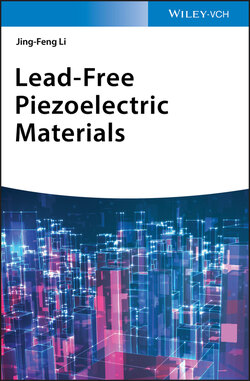Читать книгу Lead-Free Piezoelectric Materials - Jing-Feng Li - Страница 25
2.2 BaTiO3
ОглавлениеBaTiO3 is a well‐known ferroelectric material that was discovered before PZT in the 1940s during the World War II [11]. Before the emergence of PZT, BaTiO3 had been the most important piezoelectric material, which has a higher piezoelectric coefficient d33 = 120–190 pC/N than that of preceding piezoelectric materials such as triglycine sulfate (TGS), potassium dihydrogen phosphate (KDP), and quartz. BaTiO3 undergoes a series of phase transitions, from cubic to tetragonal approximately at 130 °C, then to orthorhombic at 0 °C, and further to a rhombohedral crystal structure at −90 °C, as shown in Figure 2.2 [12].
Although BaTiO3 is the first lead‐free piezoelectric compound, its Curie point (approximately 130 °C) is moderate, which limits its piezoelectric applications. Nevertheless, there are also many studies on lead‐free piezoelectrics based on BaTiO3 [13, 14]. High piezoelectricity has been reported in pure BaTiO3 single crystals [15, 16] and fine‐grained ceramics [17, 18]. In 2009, Liu and Ren reported a large piezoelectric response for the BaTiO3‐based ceramic system with a d33 coefficient >600 pC/N [19], which is comparable with soft PZT ceramics. The details will be given in Chapter 5.
BaTiO3 is often used as a model ferroelectric material for fundamental studies because of its simple composition and rich phase structures. For example, early studies have been conducted to reveal the role of Pb from a comparison between BaTiO3 and PbTiO3 [20]. Both compounds have similar cohesive properties such as unit‐cell volume (0.0632 and 0.0642 nm3, respectively), yet with distinct ferroelectric behavior. PbTiO3 has a high Curie temperature of 490 °C, and a large value of spontaneous polarization Ps (57 μC/cm2), whereas those of BaTiO3 are much lower (Ps ~ 26 μC/cm2). PbTiO3 has no low‐temperature phase transitions, whereas BaTiO3 is known to have successive phase transitions, from the cubic structure to tetragonal, orthorhombic, and rhombohedral structure at low temperature. To explain why BaTiO3 and PbTiO3 show different ferroelectric behaviors, the studies have been focused on the difference in the chemical bonds of the two perovskite compounds. Kuroiwa et al. demonstrated through calculations that the Pb and O electronic states hybridize in tetragonal PbTiO3, whereas the interaction between Ba and O is almost purely ionic in the tetragonal BaTiO3, as shown by the charge‐density distributions of cubic and tetragonal PbTiO3 and BaTiO3 in Figure 2.3 [20]. It clearly revealed that no apparent difference can be seen between the cubic phases of PbTiO3 and BaTiO3, but between their tetragonal phases. Within the latter phases, the distributions in the Pb–O and Ti–O planes of PbTiO3 are significantly different from those in the Ba–O and Ti–O planes of BaTiO3. The electron‐density distribution around the Pb and O2 sites in tetragonal PbTiO3 is quite anisotropic as shown in Figure 2.3c, i.e. extending toward the O2 and Pb, respectively. The electron densities of Pb and O2 are overlapped along the Pb–O2 direction in the tetragonal PbTiO3. However, the electron densities around Ba and O are isotropic for tetragonal BaTiO3, as shown in Figure 2.3a. These results indicate that the PbO bonds of tetragonal PbTiO3 are covalent, although they are ionic in the cubic phase. By comparing Figure 2.3b,d, it is clear that the Ti in PbTiO3 has a larger displacement than that in BaTiO3, consistent with the fact that the spontaneous polarization of PbTiO3 is larger than that of BaTiO3. This provides clear evidence for the Pb–O hybridization in tetragonal PbTiO3, which has been theoretically predicted as a key factor of much larger ferroelectricity of PbTiO3 as a representative Pb‐containing ferroelectric compound than that of BaTiO3 as a lead‐free counterpart.
Figure 2.2 Change in relative dielectric constants of BaTiO3 ceramics as a function of temperature. Inserted are the crystal structures at the corresponding temperatures.
Source: Modified from Merz [12].
The aforementioned comparison between BaTiO3 and PbTiO3 indicates that partial covalent bonding due to the Pb–O hybridization should be responsible for the high performance of Pb‐containing piezoceramics. In lead‐free counterparts, Saito et al. also found that substituting Nb with Sb, which has higher electronegativity than the former, leads to further piezoelectric property enhancement in (K,Na)NbO3‐based ceramics [10]; this is also because of the hybridization of covalency onto ionic bonding. In addition, Bi as a neighbor of Pb has a similar electronic structure with the latter, and can be used a modifier to enhance the contribution of covalent bonding.
Figure 2.3 Charge‐density distributions on (a) the (010) plane (Ba–O plane), (b) the (020) plane (Ti–O plane) of tetragonal BaTiO3 at 300 K, compared to that of tetragonal PbTiO3 at 300 K on (c) the (010) plane (Pb–O plane), and (d) the (020) plane (Ti–O plane).
Source: Reprinted with permission from Kuroiwa et al. [20]. Copyright 2001, American Physical Society.
